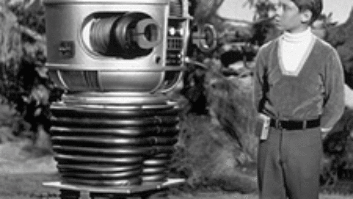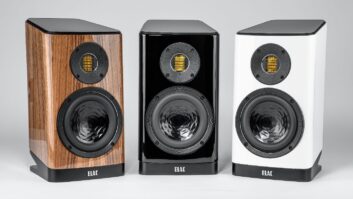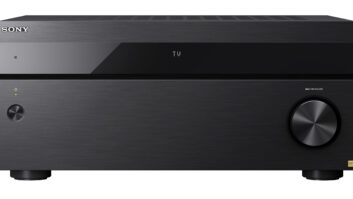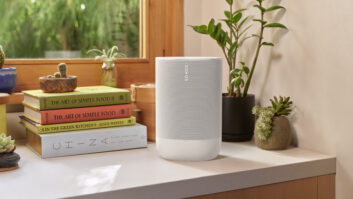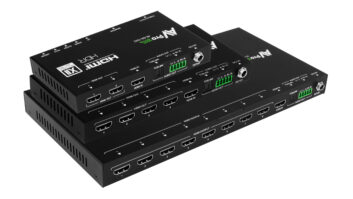“It is a riddle, wrapped in a mystery, inside an enigma; but perhaps there is a key.”
—Winston Churchill
HDCP. Have there ever been four letters that have caused a larger collective shudder from custom integrators everywhere? It works, it doesn’t work, it works again. Often there is no rhyme, reason or understanding as to why.
Last week I wrote a blog titled, What Integrators Should Take Away from CES 2015, that included a section about HDCP 2.2 where I wrote, “a new version of this copy protection — called 2.2 — will be required for displaying UHD content, and if any part of the signal chain is not HDCP 2.2 compliant then there will be no 4K picture. Adding to the confusion is that products can be HDMI 2.0 certified but not HDCP 2.2.”

Adding to the confusion about UHD TVs is that products can be HDMI 2.0 certified but not HDCP 2.2.
The takeaway was that as integrators we are expected to be at the forefront of information for our clients. Because when they buy a new 4K TV from us and hook up their (eventual) new 4K source, and get no picture, the first angry phone call is going to be to us. And it is likely going to include the phrase, “Why would you sell me a system that wouldn’t work?!?”
Admittedly the whole HDMI 2.0 and HDCP 2.2 issue is a very confusing and nebulous one. I have gone out of my way to research it, talked to industry experts, read spec sheets and chipset white papers, and I’m still not 100-percent certain on all aspects and intricacies of it.
The bottom line is that HDCP 2.2 is about protecting 4K content, and for a 4K image to work, it will have to pass through a chain of HDCP 2.2-certified and hand-shaking components. While there is currently only one true 4K source on the market – the Sony media player – there are more on the horizon. For instance, the new 4K Joey from DISH is expected to be available this summer, 4K Blu-ray players will start appearing later this year, and ultimately we’ll witness the arrival of new cable boxes and 4K media players from Apple TV, Roku, and others. And if you want to view this 4K content, every device in your video chain must have HDCP 2.2.
One thing I found out is that there is a real shortage of audio/video receivers that support HDCP 2.2 in the 4K ecosystem. And because the receiver is the connection hub for virtually every system we install and is frequently relied on to send video to the display via a single HDMI cable, this is going to be the inevitable shortcoming in systems in the months to come.
To get some information about what is here and what is coming I reached out to multiple AV receiver manufacturers to ask which – if any – of their current receivers support HDCP 2.2, how many HDCP 2.2 inputs/outputs those models have, and if no models are currently available, when we will see the first models that DO support HDCP 2.2.
Here’s what they had to say:
Anthem
“None of our current products use HDCP 2.2 but we look forward to providing support for 4K60 in 4:4:4 and BT2020 once the dust settles and UHD Blu-ray appears. The minimum HDCP 2.2 requirement doesn’t cover all of the above and shopping by version number alone can lead to disappointment.”
— Nick Platsis, Anthem Product Manager
Denon and Marantz
“No models currently [support HDCP 2.2]. Although we will be offering a free hardware upgrade to our flagship Denon AVR-X7200W and Marantz AV8802 products in the spring. [The upgrade will be for] all inputs except for the front [panel HDMI] in. And this is not the color/bandwidth limited 4K/2.2 input that you find on [some existing] products; this is full spec 4K60@4:4:4 color with HDCP 2.2. New D&M products (yet to be announced), shipping later this year will incorporate HDCP 2.2.”
– Paul Belanger, Product Manager D+M Group
Harman Kardon
“Our current range of Harman Kardon AVR does not support HDCP 2.2. Some models are HDMI 2.0 certified but without HDCP 2.2. Here are the details: AVR 1610S and AVR 1710S HDMI 2.0 with HDCP 1.4. Our next-generation product will support both HDMI 2.0 and HDCP 2.2, even if it is a bit early to provide an accurate date on availability of next generation. The first product will be a Soundbar, which we’re expecting to release in fall 2015 with other products following. As you probably know there are currently no source players available with 4K, HDCP 2.2 content, and this should not happen before the end of 2015 best case.”
— Emmanuel Millot, Director Product Marketing, Home HARMAN International
Krell
“Our Foundation 4K UHD has four HDCP 2.2 inputs out of 10 total and two HDMI outputs. We can handle 1080p60 4:4:4 with 12-bit Deep Color or 4K 60Hz 4:2:0 with 8-bit color (this is for any input, HDCP 2.2 is a separate issue). HDMI 2.0 specifies a maximum resolution of 4k 60Hz 4:4:4 but no parts exist yet to handle that (it’s twice the bandwidth of the current parts).”
— Bill McKiegan, President, Krell Industries
McIntosh
Did not respond to my information request.
Meridian
“We currently do not offer anything that is HDMI2.2 compliant. HDMI is still an evolving technology from a hardware (and firmware) standpoint. This is one of the reasons why Meridian developed its architecture of keeping HDMI outboard, with the HD621 HDMI audio processor, from the surround controller. This enables Meridian to make future changes and enhancements to the HDMI hardware (improving audio and video over HDMI) in a system without changing the entire surround controller product. While there is quite a bit of buzz around the potential benefits of HDMI 2.2, until we see real sources and implementation, we are cautious of committing clients’ money to an evolving technology.”
— Ken Forsythe, VP, Meridian America
NAD
“With the ever increasing speed of innovation, ‘premature obsolescence’ is on the minds of many customers looking to upgrade their AV systems. Modular Design Construction, NAD’s innovative chassis design that allows all major digital circuits to be replaced to add new features and capabilities, allows for an easy and affordable upgrade path. A prime example of the benefits of MDC would be the current fast evolution of HDMI and its companion copy protection HDCP. NAD has taken the position that rather than rushing an ‘incomplete’ 4K video solution we will wait a little longer for the correct semiconductors and finalized firmware before offering our complete solution as an MDC Upgrade. When the Upgrade Module is available, owners of older NADs can also benefit by upgrading their existing AVR to HDMI 2.0. Customers purchasing our flagship AVP, the M17, have a coupon entitling them to a free upgrade when the new MDC Module ships later in 2015.”
— Greg Stidsen, Director, Technology and Product Planning, Lenbrook International
Onkyo and Integra
“The following product models are all HDCP 2.2 compliant, each with one HDMI input (STB/DVR) and one HDMI output (OUT MAIN): Onkyo – TX-NR636, TX-NR737, TX-NR838, TX-NR1030, TX-NR3030, PR-SC5530, and HT-S7700; Integra – 30.6, 40.6, 50.6, 60.6, and 70.6, and pre-amp DHC-80.6.”
— Kevin Brannan, Director of Marketing, ONKYO USA Corp.
Outlaw Audio
“Presently we have one processor [and it] does not have HDCP 2.2. However, we are working on a step-up processor that will have Atmos, DTS-X, HDMI 2.0, and HDCP 2.2. How many inputs is still up in the air because of availability of just-announced chips. This is a moving target (like so many other announced technologies). Our schedule is ‘later in the year’; it is not imminent.”
— Peter Tribeman, President, Outlaw Audio
Pioneer
“The majority of our current AV receivers support full bandwidth (18Ggbps) HDMI 2.0, however they do not support HDCP 2.2. Moving forward Pioneer understands the need to support both full bandwidth HDMI 2.0 and HDCP 2.2 for compatibility with next-generation 4K sources and upcoming video technologies such as high dynamic range and expanded color gamut. Full details on our new line-up will be announced in the next few weeks.”
— Chris Walker, Director Product Planning and Marketing Pioneer Electronics
Rotel
“There are no current Rotel products that support HDCP 2.2. I would say CES 2016 is a target, but our view is that without sources it’s still a non-issue. The presumption, as well, is that future 2.2 sources will have dual outputs to maintain backward compatibility.”
— Doug Henderson, President, B&W Group North America
Sony
“The following models are currently in market and support HDMI 2.0 with HDCP 2.2: STRZA1000ES (1 in / 1 out), STRZA2000ES (1 in / 1 out), STRZA3000ES (2 in / 2 out). We just announced two more models at CES – STRDN860 and STRDN1060 – that will support HDCP 2.2 and both models will have 1 in/1 out, as well as three new soundbar models – HS-ST9, HT-NT3, HT-CT780 – that will be available in Spring 2015.”
— Samantha Albright, Consumer & Brand Marketing, Sony
Yamaha
“At this point, no Yamaha receivers are HDCP 2.2 compatible but we are closely viewing HDCP for future product implementation.”
— Yamaha spokesperson
Several manufacturers — and multiple internet forums – pointed out that while some receivers currently available are touting both HDMI 2.0 and HDCP 2.2, these models are using a chipset only capable of supporting a lower bandwidth of 10.2Gbps (similar to HDMI 1.4) and not the full, maximum 18Gbps capability of HDMI 2.0. Specifically these chips won’t be able to handle 4K/60 with 4:4:4 color sampling, but are held to a bandwidth-limited 4:2:0 color space.
Beyond any potential future sources that may or may not utilize the full 18Gbps bandwidth – such as 4K Blu-ray players that will support high dynamic range and the BT.2020 color gamut as part of the spec – there is a source out right now that does: the Pioneer Elite BDP-88FD. This new flagship Blu-ray player’s video processor upscales content to Ultra HD 4K resolution (4K/60P/4:4:4/24-bit), and the upscaled video is output utilizing HDMI 2.0’s full 18GBPS bandwidth.
Because the most commonly used HDCP 2.2 chip right now is the Silicon Image SiL9679, I reached out to them to ask about the chip’s capabilities and what would be coming on the horizon.
“The SiL9679 supports 4K resolutions that include 4K2K 24, 25, and 30 frames per second,” stated Kristin Uchiyama, senior manager, global communications, Silicon Image. “In these resolutions, color support is 8-bit RGB/YCbCr 4:4:4, as well as 8/10/12-bit YCbCr 4:2:2. Four-K2K 50 and 60 frames per second color support is 8-bit 4:2:0. These are in addition to all of the standard 480/525/720/1080p resolutions that people have used for years.
“Our [new] SiL9777 [chip] supports the full 18Gbps rate of HDMI 2.0, which adds support for 4K 50/60. In these resolutions, color support is 8-bit RGB/YCbCr 4:4:4, as well as 8/10/12-bit YCbCr 4:2:2, and the 8-bit 4:2:0 mode,” Uchiyama added.
Because many of the comments about current model limitations specifically mentioned Onkyo and Integra, I felt I would give a representative of those brands a chance to shed some light on their decision to go with this chip. “The chipset we use allows for HDMI 2.0, HDCP-2.2 copyright protection and Color Space 4:2:0,” stated Brian Sandifer, product manager for Onkyo and Integra. “We choose this chipset because all three of these actually exist and are now needed in the consumer Ultra HD space, and this is the only chipset that will support all three, which is currently available in the marketplace.
“So when HDCP-2.2 content is streamed through our AVR, it will result in both picture and sound; assuming of course that the display device is HDCP-2.2 compliant,” Sandifer continued. “Color Space 4:4:4 can eventually exist in the consumer space, but there is no content in existence to support it. If and when it ever does materialize (ie: ‘Deep Color’ for Blu-ray was in the spec but has never materialized) you will still, of course, need to be HDCP-2.2 compliant for the content to pass in full resolution, and you will have the option to turn off the 4:4:4 colorspace if devices down the line cannot support it (unlike HDCP 2.2, which you cannot turn off). Some other products are touting color space 4:4:4 capable. But, without being HDCP-2.2 compliant and with no content to support it, it is a bit of a moot point.”
Sony’s current product offerings are similarly bandwidth limited and the company’s senior product marketing manager, home audio, Aaron Levine, weighed in on this as well. “We want to point out what will determine what type of content is available to consumers is not just HDMI 2.0 but copyright protection with HDCP 2.2,” he said. “It is unlikely that copyrighted protection will utilize the full 4K60P bandwidth in the near future due to bandwidth (file size) and production (film) issues. Also, the chip sets currently in the market only offer HDMI 2.0 (HDCP 2.2) 10 Bit 4:2:2 4K 60P. Our receiver line-up features exactly the content bandwidth that is needed today and in the near future to maximize the experience from both broadcast, movie streaming and disc capabilities.”
Levine noted that Sony’s 4K media player, FMP-X10, “supports a wider color space and HDMI 2.0 but does not support the full BT2020 color space and high dynamic range. Our line-up features the specs that are actually needed to support content today.”
Sandifer added that it’s a bit too early to discuss the specifics of next-generation AV receivers. “Typically we are fortunate enough to be on the forefront of new technology, hardware, processing, etc.,” he said, “so I would expect the same this year as new models start rolling out in a few months. We typically start rolling out entry-level products in March-April and transition the rest of the line over the next few months, culminating in the release of our top-end models in summer/fall.”
While some manufacturers are hoping to dodge the HDCP 2.2 bullet by leaning on sources that will have dual outputs — one HDCP 2.2 for sending HDCP 2.2 protected video directly to the display, and another for sending non-HDCP 2.2 audio to the receiver — a la the Sony FMP-X10 server and the way some Blu-ray players handled 3D video, it’s clear that this won’t be the case for every source. For example, the upcoming 4K Joey will only include a single HDCP 2.2 HDMI output.
Compounding the potential problem is that an upgrade to HDMI 2.0 and HDCP 2.2 won’t be something that can be handled by a simple firmware or software update. It will require significant amounts of new hardware and would be an update that likely wouldn’t be able to be performed in the field. Beyond Denon and Marantz — which are offering complimentary upgrades for customers purchasing the company’s respective flagship models — and NAD, whose unique Modular Design Construction allows for “cards” supporting new features to be easily added — no company has made any mention of an upgrade path short of purchasing a new model. In fact one manufacturer told me that it would cost them around $350 per unit to perform an upgrade. On the upside for retailers and dealers, this means that every receiver and processor currently on the market is about to become obsolete. On the downside, expect some awkward conversations from any customer that purchased a high-end piece recently.
Sony is uniquely poised to deliver 4K content to the consumer as the only company that has “Hollywood to Home” pipeline, literally involved in every aspect from lens to home screen. I asked Sony’s Levine what his company thought of these HDMI and HDCP issues as we transition into a UHDTV world.
“As a founder in the HDMI coalition, and a major part of the UHD alliance as well as the HDR Alliance, Sony is working with the industry to insure consumers get the best possible 4K experience at home, from source to sound,” Levine said. “We know that 4K will continue to grow in the marketplace. We are seeing prices drop as content increases, so our goal is to support the overall consumer experience. We see the full 4K experience being exactly what today’s consumer needs, both picture and sound, and our goal is to optimize 4K content that is available to consumers now and in the near future.”
It is likely that within the next one to two product cycles we’ll have a plethora of receivers to select from that will support full bandwidth HDMI 2.0 and HDCP 2.2 on all inputs and outputs. One manufacturer commented that he couldn’t see this not being ubiquitous at all budget points and on all models. But for now, the industry is in a definite state of transition. As an integrator, knowledge is power, and the more you know, the better prepared you’ll be able to help your customers make informed decisions that lead to black-screen-of-death situations.
John Sciacca is principal of Custom Theater and Audio in Myrtle Beach, SC.

